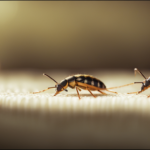Beginners Guides
What Are The Tiny Bugs In My House
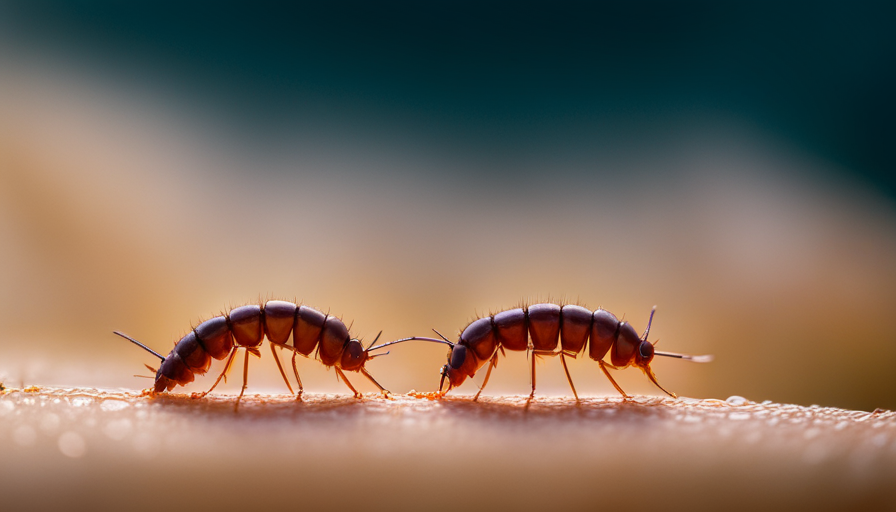
Have you ever pondered about those small insects in your home? They seem to materialize from thin air, creeping along your walls or darting over your kitchen countertop. However, worry not, as I stand ready to furnish you with the information you desire.
In this article, we will explore the world of these minuscule creatures, diving into their identification, behavior, signs of infestation, prevention tips, and even natural remedies for getting rid of them. We will also discuss the importance of hiring professional pest control services and how to deal with specific bug infestations.
Furthermore, I will share some valuable insights on protecting your home from future infestations and shed light on the potential health risks associated with these tiny bugs.
So, let us embark on this scientific journey together to uncover the secrets of the tiny bugs that inhabit our homes.
Key Takeaways
- Identifying the anatomy and common hiding places of tiny bugs in homes is important for effective bug control.
- Taking preventive measures such as keeping a clean and clutter-free environment, sealing entry points, and eliminating moisture can help prevent bug infestations.
- Natural remedies like aloe vera and tea tree oil can be used to soothe bug bites or skin irritation.
- If DIY methods are not effective, it may be necessary to hire professional pest control services to address bug infestations.
Identifying Common Types of Tiny Bugs
If you spot tiny bugs scurrying across your kitchen counter, they could be ants, spiders, or even minuscule beetles. To properly identify these pests, it’s important to understand their anatomy.
Ants have a distinct segmented body with a narrow waist, while spiders have eight legs and two body sections. Beetles, on the other hand, have a hard shell-like covering called an exoskeleton.
In addition to understanding insect anatomy, knowing their common hiding places can help in identification. Ants often nest in cracks and crevices, while spiders prefer dark and secluded areas like corners and under furniture. Beetles can be found in stored food products or hiding in damp areas like basements or bathrooms.
By familiarizing yourself with the anatomy and hiding places of these tiny bugs, you can identify them more accurately. This understanding is essential in effectively managing and controlling their presence in your home.
Transitioning into the next section about understanding their behavior, it’s crucial to observe their movements and patterns to gain a deeper insight into how these bugs behave and interact within your living space.
Understanding Their Behavior
When these tiny creatures invade, their intricate movements and patterns of behavior become a captivating mystery to unravel. Understanding their behavior is crucial in effectively dealing with them.
To comprehend their actions, it’s essential to delve into their life cycle and feeding habits. Tiny bugs, like any other living organisms, go through a life cycle consisting of various stages, such as egg, nymph, and adult. Each stage has distinct characteristics and behaviors. By studying their life cycle, we can gain insight into their reproductive patterns and develop strategies to disrupt their reproductive cycles.
Feeding habits play a significant role in the behavior of tiny bugs. Some species feed on organic matter, such as decaying food or plant material, while others prey on other insects. Understanding their feeding preferences can help us identify potential food sources within our homes and implement proper sanitation practices to deprive them of sustenance.
To evoke an emotional response in the audience, here are five bullet points:
- Witnessing their relentless search for food can be both fascinating and unsettling.
- The synchronized movements of these tiny creatures can create a sense of awe and wonder.
- Their ability to adapt and thrive in various environments can instill a sense of admiration.
- The potential damage they can cause to our homes can invoke feelings of frustration and helplessness.
- The constant presence of these minuscule beings can fuel a deep desire to eradicate them.
Understanding the behavior of these tiny bugs is just the first step in dealing with their infestation. By recognizing the signs of infestation, we can take appropriate action to eliminate them from our homes and regain control.
Signs of Infestation
When trying to determine if your home is infested with bugs, there are several key signs to look out for. First, keep an eye out for visible bugs such as ants, cockroaches, or bed bugs. These pests are often seen crawling around in corners, under furniture, or in cracks and crevices.
Additionally, be on the lookout for any signs of damage to your property, such as chewed wires or holes in fabrics or wood.
Lastly, pay attention to any bites or skin irritation you may be experiencing, as this could be a sign of a bug infestation.
Visible Bugs
As I walk through my house, I spot tiny bugs scurrying across the floor. These pests can be quite a nuisance, and it’s important to understand their diet and common hiding places in order to effectively eliminate them. To help you better understand these tiny intruders, I have created a table detailing their habits:
| Habits | Diet | Common Hiding Places |
|---|---|---|
| Behavior | They are attracted to food and moisture | Cracks and crevices |
| Under appliances | ||
| Behind baseboards | ||
| Inside pantry | ||
| In bathroom cabinets |
By knowing where these bugs tend to hide, you can take appropriate measures to keep them at bay. However, if left unchecked, these tiny bugs can cause damage to property.
Damage to Property
Unbeknownst to many homeowners, these pesky critters can wreak havoc on their property if they’re not dealt with promptly. Here are three ways they can cause damage:
-
Structural damage: Bugs like termites and carpenter ants can chew through wood, causing structural weaknesses and compromising the integrity of your home.
-
Contamination: Some bugs, such as cockroaches and rodents, can contaminate food and surfaces with their droppings, saliva, and hair, posing health risks.
-
Electrical damage: Certain bugs, like ants, are attracted to electrical wiring and may chew through insulation, leading to short circuits and potential fire hazards.
To alleviate bug bites, you can try natural remedies such as applying aloe vera or tea tree oil to the affected area. Additionally, common household bug phobias can be managed through exposure therapy and seeking professional help if necessary.
With the potential for property damage covered, let’s now explore the topic of bites or skin irritation.
Bites or Skin Irritation
To alleviate the discomfort caused by bug bites or skin irritation, you can soothe the affected area with natural remedies like aloe vera or tea tree oil. These remedies have been known to reduce inflammation, relieve itching, and promote healing. Aloe vera contains compounds that have antiseptic and anti-inflammatory properties, while tea tree oil has antimicrobial properties that can help prevent infection.
In addition to natural remedies, it is important to be aware of the potential health risks associated with bug bites or skin irritation. Some bugs, such as mosquitoes and ticks, can transmit diseases like West Nile virus or Lyme disease. It is crucial to monitor any symptoms that may arise after a bite and seek medical attention if necessary.
Taking preventive measures is key to avoiding bug bites and skin irritation. By keeping your house clean and free of clutter, sealing any cracks or openings, and using screens on windows and doors, you can minimize the presence of bugs in your home.
Prevention Tips
To prevent infestations of tiny bugs in my house, I must keep a clean and tidy home. This means regularly cleaning and vacuuming all areas, especially those prone to moisture and food crumbs.
Additionally, sealing entry points such as cracks and gaps in windows, doors, and walls can help prevent these pests from entering in the first place.
Lastly, eliminating moisture and standing water, both inside and outside the house, is crucial as it attracts and supports the growth of bugs.
By following these prevention tips, I can reduce the risk of infestations and maintain a bug-free home.
Keep a Clean and Tidy Home
Maintaining a spick-and-span abode not only keeps those pesky critters at bay but also creates a sanctuary of cleanliness and tranquility for you to enjoy.
To prevent bug breeding, it’s crucial to maintain a clutter-free environment. Tiny bugs, such as ants and cockroaches, are attracted to food crumbs and spills, so it’s important to clean up any messes promptly. Additionally, regularly vacuuming and sweeping can help eliminate any potential hiding places for bugs.
Remember to keep your kitchen clean and store food in tightly sealed containers. Lastly, decluttering your home not only reduces potential hiding spots for bugs but also makes it easier to spot any signs of an infestation.
By maintaining a clean and tidy home, you’re taking the first step in preventing bug problems.
Now, let’s move on to the next section about sealing entry points.
Seal Entry Points
Creating a barrier against unwanted visitors starts with sealing off entry points in your home. It’s important to identify and seal any cracks or gaps in walls, doors, windows, and foundations.
Tiny bugs can easily find their way into your house through these openings. To effectively seal entry points, use caulk or weatherstripping to fill in gaps and cracks. Additionally, installing door sweeps and window screens can help keep bugs out. Natural repellents, such as essential oils like lavender or peppermint, can also be used around entry points to deter bugs.
By sealing off these entry points, you can prevent bugs from entering your home and reduce the need for chemical pesticides.
Transitioning into the next section, it’s also crucial to eliminate moisture and standing water, as these provide breeding grounds for bugs.
Eliminate Moisture and Standing Water
By getting rid of excess moisture and standing water, you can ensure that your home remains bug-free and as dry as a bone. Tiny bugs, such as ants and cockroaches, are attracted to moist environments, making your house an ideal breeding ground for them.
To eliminate moisture, fix any leaks or plumbing issues in your home. Make sure to regularly clean and dry areas prone to moisture, such as bathrooms and kitchens. Additionally, ensure that your gutters and downspouts are functioning properly to prevent water accumulation around your house.
If you are still facing bug problems despite your efforts, it may be necessary to seek professional help. Pest control experts can assess the situation and provide effective solutions tailored to your specific needs.
With these measures in place, you can now explore natural remedies for getting rid of tiny bugs without compromising the dryness of your home.
Natural Remedies for Getting Rid of Tiny Bugs
There are various natural remedies you can try to effectively eliminate those tiny bugs in your house. These natural repellents and non-toxic solutions aren’t just safe for your family and pets, but also for the environment.
Here are four effective methods you can use:
-
Essential oils: Certain essential oils like peppermint, lavender, and eucalyptus have natural insect-repelling properties. Dilute a few drops of these oils with water and spray the solution in areas where you see the bugs.
-
Vinegar: Create a mixture of equal parts vinegar and water and spray it on surfaces where bugs are often found. The strong smell of vinegar repels them, making your house less attractive to them.
-
Diatomaceous earth: This natural substance is made from the fossilized remains of tiny aquatic organisms. Sprinkle diatomaceous earth in areas where bugs are present, such as cracks and crevices. The sharp particles will damage their exoskeletons, ultimately killing them.
-
Citrus peels: Save your citrus peels, like orange or lemon peels, and place them near bug-infested areas. The strong scent of citrus acts as a natural deterrent, keeping bugs at bay.
By incorporating these natural remedies, you can effectively control and eliminate those tiny bugs in your house. However, if the infestation persists or becomes overwhelming, it may be time to consider hiring professional pest control services.
Hiring Professional Pest Control Services
When it comes to dealing with a pest infestation in my home, there are certain situations when I know it’s time to call a professional pest control service. These situations can include a large-scale infestation that I can’t handle on my own, or if the pests are causing significant damage to my property.
Choosing the right pest control company is crucial, as it ensures that the problem is addressed effectively and safely. Additionally, I always look for long-term solutions to prevent future infestations and maintain a pest-free home.
When to Call a Professional
If your tiny house guests are starting to feel like unwelcome roommates, it might be time to bring in the bug-busting cavalry. While some infestations can be taken care of with do-it-yourself methods, there are certain situations where calling a professional pest control service is the best course of action.
One sign of a severe infestation is when the bugs are present in large numbers and are causing significant damage to your home or property. Additionally, if you’ve tried DIY methods without success or if you’re dealing with a pest that poses a health risk, it’s important to call in the experts.
Choosing the right pest control company is essential to effectively eliminate the pests from your home and prevent future infestations.
Choosing the Right Pest Control Company
To find the perfect pest control company for your needs, imagine a team of experts arriving at your doorstep, equipped with state-of-the-art tools and a wealth of knowledge to tackle any infestation. When choosing a pest control company, it’s essential to consider factors such as pest control pricing and the effectiveness of their services.
While DIY pest control may seem like a cost-effective option, it often fails to address the root cause of the problem, leading to recurring infestations. Hiring a professional pest control company ensures that the issue is handled efficiently and effectively, saving you time and money in the long run. Furthermore, they have access to specialized products and techniques that may not be available to the general public.
Transitioning into the subsequent section about long-term solutions, it’s crucial to understand that effective pest control extends beyond a one-time treatment.
Long-Term Solutions
For long-term solutions, you need to consider how a professional pest control company can help you maintain a pest-free environment in your home. Here are some ways they can assist you:
-
Natural Insecticides: Pest control experts have access to a wide range of natural insecticides that are effective in eliminating pests without harming the environment or your health.
-
Home Remedies: Professionals can provide you with expert advice on using home remedies to prevent and control pest infestations. They can guide you on the proper application of natural remedies like vinegar, baking soda, or essential oils.
-
Regular Inspections: Pest control companies can conduct regular inspections to identify any signs of pest activity in your home. This proactive approach helps prevent infestations before they become a major problem.
-
Pest-Proofing: Professionals can help you identify and seal off entry points to prevent pests from entering your home in the first place.
By utilizing these long-term solutions, you can effectively maintain a pest-free environment. Now, let’s move on to dealing with specific bug infestations.
Dealing with Specific Bug Infestations
When it comes to dealing with specific bug infestations in my house, there are several key points to consider.
First, I need to understand the various ant control methods available, such as baiting, spraying, or using natural remedies.
Second, I must address the issue of termite infestation by exploring different extermination options, including chemical treatments or professional fumigation.
Lastly, I need to be aware of effective bedbug treatment techniques, such as heat treatment or insecticide application.
Additionally, it’s important to know how to effectively remove fleas from my home and prevent silverfish infestations through proper moisture control and elimination of their food sources.
Ant Control Methods
There’s nothing more frustrating than finding those pesky ants invading your home. To combat these tiny intruders, there are several natural ant repellents and ant bait stations that can be effective.
Natural ant repellents, such as peppermint oil, vinegar, and cinnamon, can be sprayed or placed strategically to deter ants from entering your home. Additionally, ant bait stations are another popular method to control ant infestations. These stations contain a sweet, sticky substance that attracts ants. Once the ants consume the bait, they bring it back to their colony, effectively killing the entire colony.
By using a combination of natural ant repellents and ant bait stations, you can effectively control and eliminate ant infestations in your home.
Moving on to termite extermination, it’s important to take immediate action to prevent further damage.
Termite Extermination
To rid your home of those destructive termites, you need to act swiftly and decisively, unleashing a force that’ll demolish their ranks and protect your fortress from their relentless assault.
Termite prevention is key in stopping their infestation. Start by inspecting your property for signs of termite damage, such as hollow-sounding wood or mud tubes along the foundation. Assess the extent of the damage and identify the type of termites present. This’ll help you determine the most effective termite extermination method.
Options include liquid termiticides, baiting systems, and fumigation. Consider consulting a professional pest control company for a thorough assessment and tailored treatment plan.
By taking these proactive measures, you can safeguard your home from the destructive nature of these tiny pests.
Now, let’s delve into the subsequent section about bedbug treatment.
Bedbug Treatment
Bedbugs can infest our beds and furniture, causing us sleepless nights and itching discomfort. These tiny insects are expert hitchhikers and can easily travel from one place to another, making it essential to take preventive measures. Regularly inspecting and cleaning bedding, furniture, and surrounding areas can help in early detection. In case of an infestation, several treatment options are available. Heat treatment involves exposing the affected items to high temperatures, which effectively kills the bedbugs. Another option is chemical treatment, where insecticides are used to eliminate the pests. It is important to follow the instructions carefully and consult a professional for the most effective treatment method. Remember, swift action is crucial to prevent the infestation from spreading. Transitioning into the next section, flea removal is another common issue that homeowners face.
Flea Removal
After successfully treating my home for bedbugs, it became apparent that another tiny pest had made itself at home: fleas. Fleas are small, wingless insects that feed on the blood of mammals and birds. They are a common nuisance in households with pets, as they can easily be brought inside on the fur of dogs or cats.
To prevent fleas from infesting my home, I took several measures. First, I treated my pets with a flea preventative medication recommended by my veterinarian. Additionally, I vacuumed frequently, paying close attention to areas where my pets spend the most time. I also washed my pet’s bedding and any other fabric items they come into contact with regularly. Finally, I considered using flea control methods such as flea sprays or foggers if the infestation persists.
Transitioning to the next topic, it is important to also address the prevention of silverfish, another common household pest.
Silverfish Prevention
One effective way to prevent silverfish from infesting a home is by investigating the truth of a theory that suggests using cedarwood to create an environment that is unfavorable for these pests.
Silverfish are known to dislike the scent of cedarwood, which makes it a potential natural remedy for pest control. By placing cedarwood chips or blocks in areas where silverfish are commonly found, such as closets, attics, and basements, homeowners can deter these insects from infesting their homes.
The aromatic oils in cedarwood act as a repellent, making it an effective tool for keeping silverfish at bay. Additionally, cedarwood has antimicrobial properties that can help prevent the growth of mold and other fungi, which are often attractive to silverfish.
By incorporating cedarwood into our pest control strategies, we can protect our homes from future infestations.
Protecting Your Home from Future Infestations
To keep those pesky little bugs from invading your home again, it’s crucial to take proactive measures for protecting your living space.
One effective way to deter future infestations is by using natural repellents. Certain scents, such as lavender, peppermint, and eucalyptus, are known to repel insects like silverfish. You can create your own DIY pest control solutions by mixing essential oils with water and spraying them around potential entry points, such as windowsills and doorways.
Additionally, keeping your home clean and free of clutter will make it less attractive to these tiny bugs. Regularly vacuuming and dusting can help remove any existing eggs or larvae, preventing further infestation.
Sealing cracks and crevices with caulk or weatherstripping is another important step in protecting your home. These measures not only keep silverfish away but also deter other pests from entering your living space.
By taking these proactive steps, you can ensure a bug-free home and reduce the risk of health issues associated with these tiny creatures.
Health Risks Associated with Tiny Bugs
I will now discuss the health risks associated with tiny bugs, focusing on two key points: allergies and asthma, and disease transmission. As someone who’s dealt with these issues firsthand, I understand the importance of addressing these concerns.
Tiny bugs can trigger allergies and asthma symptoms in susceptible individuals, leading to respiratory distress and discomfort. Additionally, certain bugs can transmit diseases, posing a threat to our health and well-being.
It’s crucial to be aware of these risks and take necessary precautions to protect ourselves and our homes.
Allergies and Asthma
If you’re constantly sneezing and wheezing, those tiny bugs in your house are like invisible triggers for your allergies and asthma. These pests can cause a variety of respiratory problems, exacerbating existing conditions and making it harder to breathe. Common allergy triggers found in homes include dust mites, cockroaches, and pet dander. When these bugs are present in your living space, they release allergens into the air that can irritate your nasal passages and lungs, leading to symptoms such as congestion, coughing, and difficulty breathing. For individuals with asthma, exposure to these allergens can even trigger severe asthma attacks. To help you understand the impact of these bugs on your health, consider the following table:
| Allergy Triggers | Respiratory Problems |
|---|---|
| Dust mites | Nasal congestion |
| Cockroaches | Coughing |
| Pet dander | Difficulty breathing |
By understanding the connection between these tiny bugs and your allergies and asthma, you can take steps to minimize your exposure and improve your respiratory health. Moving forward, let’s explore how these bugs can also contribute to disease transmission.
Disease Transmission
Invisible triggers in our living spaces, such as dust mites, cockroaches, and pet dander, can not only worsen allergies and asthma but also contribute to the transmission of diseases. It is important to understand the role these tiny bugs play in disease prevention and transmission control.
Dust mites, for example, are microscopic creatures that thrive in warm and humid environments. They feed on dead skin flakes and their waste particles can trigger allergic reactions.
Cockroaches, on the other hand, carry pathogens on their bodies and can contaminate food and surfaces, leading to the spread of diseases like salmonella and E. coli.
Pet dander, composed of tiny flecks of skin shed by animals, can also trigger allergies and asthma in susceptible individuals.
To minimize the risk of disease transmission, it is crucial to maintain cleanliness, control humidity levels, and regularly clean and vacuum our living spaces.
Frequently Asked Questions
Can tiny bugs in my house cause damage to my furniture or belongings?
Yes, unfortunately, tiny bugs in your house can cause damage to your furniture and belongings. To prevent this, you can use preventive methods like regular cleaning, sealing cracks, and storing food properly.
How can I tell if the tiny bugs in my house are biting me?
To determine if the tiny bugs in your house are biting you, look for signs of bug bites such as red, itchy welts. To prevent bug bites, keep your house clean, seal any entry points, and use insect repellent.
Are tiny bugs in my house harmful to my pets?
Tiny bugs in your house can be harmful to your pets. They can cause potential allergic reactions and impact indoor air quality. It’s important to identify and eliminate these bugs to ensure the well-being of your furry friends.
What should I do if I find tiny bugs in my pantry or kitchen?
If I find tiny bugs in my pantry or kitchen, I can take preventive measures like keeping food containers sealed and cleaning regularly. Natural remedies like vinegar or essential oils can also be effective in repelling these pests.
Can tiny bugs in my house transmit diseases to humans?
Tiny bugs in houses, like mosquitoes in a swamp, can transmit diseases to humans through biting or contact. To prevent transmission, I recommend using insect repellents, keeping a clean environment, and sealing entry points.
Conclusion
In conclusion, it’s crucial to identify and understand the behavior of the tiny bugs in your house to effectively deal with them.
By recognizing signs of infestation early on and implementing prevention tips, you can protect your home from future bug invasions.
Natural remedies can be effective in getting rid of these pesky creatures, but sometimes it’s necessary to hire professional pest control services.
Remember, tiny bugs can pose health risks, so taking action promptly is essential.
Don’t let these minuscule critters bug you any longer!
Hi, I’m Emma. I’m the Editor in Chief of Tiny House 43, a blog all about tiny houses. While tree houses are often associated with childhood, they can be the perfect adult retreat. They offer a cozy space to relax and unwind, surrounded by nature. And since they’re typically built on stilts or raised platforms, they offer stunning views that traditional homes simply can’t match. If you’re looking for a unique and romantic getaway, a tree house tiny house might just be the perfect option.
Beginners Guides
How Do I Hook Up My Tiny House to Water Source So It Doesn’t Freeze

So, you’ve got yourself a cute little tiny house, huh? Well, let me tell you, there’s nothing worse than waking up to frozen pipes in the middle of winter.
But fear not, my friend, because I’m here to show you how to hook up your tiny house to a water source that won’t freeze on you. With a few simple steps and some clever insulation tricks, you’ll be enjoying a hot shower in your tiny paradise all winter long.
Let’s get started, shall we?
Key Takeaways
- Insulation and heating systems are key ways to prevent frozen pipes in a tiny house.
- Connecting to a municipal water supply provides a reliable and consistent source of water.
- Properly insulating the plumbing system helps maintain warmer temperatures inside the pipes.
- Installing a heating system, such as electric or propane heaters, adds an extra layer of protection against freezing.
Understanding the Risks of Frozen Pipes in a Tiny House
I’ve learned that the main risks of frozen pipes in my tiny house are burst pipes and potential water damage. Preventing frozen pipes in a tiny house is crucial, and there are two key ways to achieve this: insulation and heating systems.

Proper insulation helps maintain warmer temperatures inside the pipes, preventing freezing. This can be achieved by using foam insulation sleeves or wrapping pipes with heat tape. Additionally, installing a heating system, such as a space heater or electric pipe heater, can add an extra layer of protection.
Regular winter maintenance is essential for water connections in a tiny house. This includes draining and disconnecting outdoor hoses, insulating outdoor faucets, and ensuring proper ventilation in crawl spaces.
Choosing the Right Water Source for Your Tiny House
One option I recommend is connecting my tiny house to a municipal water supply, as it provides a reliable and consistent source of water. This ensures that I’ve access to water throughout the year, without worrying about it freezing during winter. Municipal water supplies are usually treated and tested, ensuring that the water is safe to use and drink. Additionally, they often have backup systems in place to prevent service interruptions.
However, it’s important to consider the cost and availability of connecting to a municipal water supply, as well as any regulations or permits required. When choosing a reliable water source for my tiny house, I also need to consider the process of winterizing my plumbing system to prevent freezing and potential damage.

Insulating Your Plumbing System to Prevent Freezing
To prevent freezing, I’ll need to insulate both the pipes and the walls surrounding them. Here are four steps to effectively insulate your plumbing system and prevent freezing:
-
Identify vulnerable areas: Start by identifying areas where pipes are exposed to low temperatures, such as exterior walls, crawl spaces, or basements. These areas are more prone to freezing.
-
Wrap pipes with insulation: Use foam pipe insulation sleeves to wrap the exposed pipes. This will provide a layer of insulation and minimize heat loss. Make sure to cover all joints and fittings.
-
Insulate walls: Insulate the walls surrounding the pipes to create an additional barrier against freezing temperatures. Use insulation material like fiberglass or foam board insulation.

-
Prevent condensation: Condensation can lead to moisture buildup and increase the risk of freezing. To prevent condensation, consider using heat tape on the pipes. Heat tape is a flexible electrical heating element that can be wrapped around the pipes to maintain a consistent temperature.
Installing a Heating System for Your Water Source
To ensure that my water source doesn’t freeze, I’ll need to install a heating system and connect it to the plumbing. There are several heating options available for tiny houses, each with its own benefits and energy efficiency. Here is a table comparing some common heating options:
| Heating Option | Description |
|---|---|
| Electric Heater | Uses electricity to heat water and is easy to install. However, it can be costly to operate. |
| Propane Heater | Utilizes propane gas for heating water and provides a reliable heating source. It is energy-efficient and suitable for off-grid living. |
| Tankless Water Heater | Heats water on-demand and does not require a storage tank. It is energy-efficient and saves space. |
| Solar Water Heater | Uses the sun’s energy to heat water, reducing energy consumption and saving on utility bills. However, it requires ample sunlight. |
Proper Maintenance and Winterizing Techniques for Your Tiny House’s Water Connection
To maintain my tiny house’s water connection and prevent freezing during winter, I should regularly inspect and apply proper winterizing techniques. Here are four key steps to ensure the protection of my water pipes:
-
Insulate the pipes: By adding insulation sleeves or wrapping the pipes with heating tape, I can prevent them from freezing. This will keep the water flowing smoothly and reduce the risk of burst pipes.

-
Seal any gaps or cracks: I should thoroughly inspect the areas where the pipes enter the house and seal any gaps or cracks. This will prevent cold air from entering and keep the pipes warm.
-
Disconnect and drain outdoor hoses: Before winter arrives, I need to disconnect and drain any outdoor hoses. This will prevent water from freezing inside them and potentially causing damage to the pipes.
-
Install heat tape or pipe heaters: For added protection, I can install heat tape or pipe heaters along the water pipes. These devices provide consistent heat and prevent freezing.
Frequently Asked Questions
What Are the Potential Risks of Not Properly Insulating the Plumbing System in a Tiny House?
Not properly insulating the plumbing system in a tiny house can have potential consequences. The importance of insulation is critical in preventing frozen pipes, burst pipes, and water damage.

Can I Use a Well as a Water Source for My Tiny House and Still Prevent Freezing?
Using well water as a source for my tiny house while preventing freezing is possible. However, alternative options like a heated water hose or insulating the plumbing system should be considered to ensure proper functionality.
Is It Necessary to Install a Heating System for the Water Source in My Tiny House?
Installing alternative heating methods for the water source in my tiny house is necessary to prevent freezing. Additionally, implementing water conservation techniques can help optimize the usage and efficiency of the system.
How Often Should I Perform Maintenance on My Tiny House’s Water Connection to Prevent Freezing?
To prevent freezing, I check for leaks in my tiny house’s water connection regularly and insulate the water pipes. Maintenance is crucial, so I perform these tasks at least once a month.
Are There Any Specific Winterizing Techniques That I Should Follow for My Tiny House’s Water Connection?
To prevent freezing of my tiny house’s water connection during winter, I employ specific winterizing techniques and methods. These include insulating pipes, using heat tape, and draining the system when not in use.

Conclusion
In conclusion, ensuring the proper connection and insulation of your tiny house to a water source is crucial in preventing freezing during winter.
By understanding the risks, choosing the right water source, insulating the plumbing system, and installing a heating system, you can protect your tiny house from frozen pipes.
Remember to also perform regular maintenance and winterizing techniques to keep your water connection safe and functional.
Keep your tiny house warm and worry-free this winter!

I’m Theodore, and I love tiny houses. In fact, I’m the author of Tiny House 43, a book about tiny houses that are also tree houses. I think they’re magical places where imaginations can run wild and adventures are just waiting to happen.
While tree houses are often associated with childhood, they can be the perfect adult retreat. They offer a cozy space to relax and unwind, surrounded by nature. And since they’re typically built on stilts or raised platforms, they offer stunning views that traditional homes simply can’t match.
If you’re looking for a unique and romantic getaway, a tree house tiny house might just be the perfect option.
Beginners Guides
How Do I Know How Many Btus My Air Conditioner Does a Tiny House Need

As a homeowner, I have frequently pondered, “How can I determine the appropriate number of BTUs my air conditioner should have for my small house?” This is a common yet essential question. Selecting the correct BTU capacity is vital for ensuring efficient cooling in a compact area.
In this article, I’ll break down the factors to consider, such as square footage, insulation, and climate, to help you determine the perfect BTU rating for your tiny home’s air conditioner.
So, let’s dive in and find the answer together.
Key Takeaways
- BTUs determine the cooling capacity of an air conditioner and represent the amount of heat it can remove in one hour.
- Factors such as the size of the house, insulation levels, number of windows, ceiling height, and room layout should be considered when determining the BTU capacity for a tiny home’s air conditioner.
- Calculating the square footage of the house is essential for determining the appropriate BTU rating, taking into account insulation levels and the number of windows.
- Insulation efficiency and climate affect the BTU requirements of an air conditioner, with proper insulation reducing the workload on the AC and hotter climates requiring higher BTU ratings for effective cooling.
Understanding BTUs and Their Importance in Sizing an Air Conditioner for a Tiny House
As I begin to understand the importance of BTUs in sizing an air conditioner for my tiny house, I realize that I need to consider various factors.

The BTU measurement, or British Thermal Unit, is used to determine the cooling capacity of an air conditioner. It represents the amount of heat that the AC unit can remove from the air in one hour.
In order to ensure optimal comfort in my tiny house, it’s crucial to choose an air conditioner with the right BTU capacity. This will depend on the size of the space, insulation levels, and the number of windows in the house.
Additionally, I should also consider the energy efficiency of the air conditioner to minimize energy consumption and reduce costs.
Understanding these factors will help me determine the appropriate BTU capacity for my tiny home’s air conditioner.
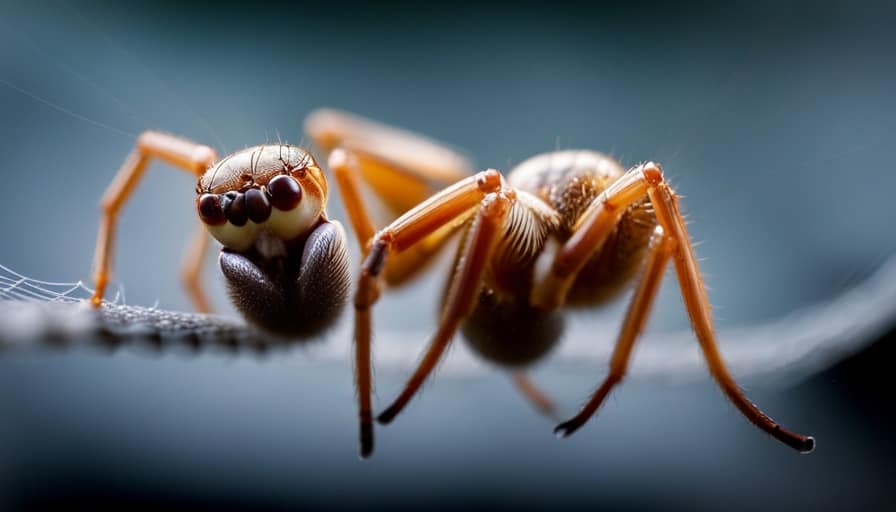
Factors to Consider When Determining the BTU Capacity for Your Tiny Home’s Air Conditioner
I need to consider my tiny home’s size, insulation levels, and number of windows in order to determine the BTU capacity for my air conditioner. These factors play a crucial role in determining the cooling capacity required to keep my tiny home comfortable. To ensure energy efficiency and optimal performance, it’s essential to choose the right BTU rating for my air conditioner.
Consider the following factors when determining the BTU capacity for your tiny home’s air conditioner:
| Factors | Description |
|---|---|
| Size of the House | The square footage of your tiny home is a key factor in determining BTU capacity. A larger space will require a higher cooling capacity. |
| Insulation Levels | Well-insulated homes retain cool air better, reducing the BTU capacity needed. |
| Number of Windows | Windows contribute to heat gain. More windows may require a higher BTU capacity. |
Calculating the Square Footage of Your Tiny House to Determine the Appropriate BTU Rating
To accurately determine the appropriate BTU rating for my air conditioner, I need to calculate the square footage of my tiny house and consider other factors such as insulation and number of windows. Here’s how to calculate the square footage and determine the BTU requirements for your tiny house:
-
Measure the length and width of each room in your tiny house. Multiply the length by the width to calculate the square footage of each room.

-
Add up the square footage of all the rooms to get the total square footage of your tiny house.
-
Consider the insulation in your walls, roof, and floor. Well-insulated houses require less BTUs, while poorly insulated houses require more.
-
Take into account the number and size of windows in your tiny house. Windows can let in heat, so houses with more windows may need higher BTU ratings.
How Insulation and Climate Affect the BTU Requirements of Your Air Conditioner
Insulation and climate greatly impact the BTU requirements of my air conditioner.

Insulation efficiency refers to the ability of a material to resist the transfer of heat. Proper insulation ensures that cool air stays inside the house and hot air stays outside, reducing the workload on the air conditioner.
Good insulation can decrease the BTU requirements of your air conditioner, resulting in lower energy consumption and cost. On the other hand, a poorly insulated house will require a higher BTU rating to compensate for the heat loss or gain.
Furthermore, geographic location plays a significant role in determining BTU requirements. Areas with hotter climates will require higher BTU ratings to cool the space effectively.
Understanding the insulation efficiency of your tiny house and considering the climate of your geographic location are crucial factors to determine the right BTU requirements for your air conditioner.

Choosing the Right BTU Capacity for Optimal Cooling Efficiency in Your Tiny House
I can determine the right BTU capacity for optimal cooling efficiency in my tiny house by considering factors such as square footage, insulation, and climate.
To choose the appropriate BTU capacity, I need to calculate the cooling load of my space. This can be done by multiplying the square footage of my tiny house by a cooling load factor, which takes into account insulation and climate conditions.
Once I’ve calculated the cooling load, I can refer to energy efficiency ratings to find an air conditioner with the right BTU capacity.
Here are four important factors to consider:
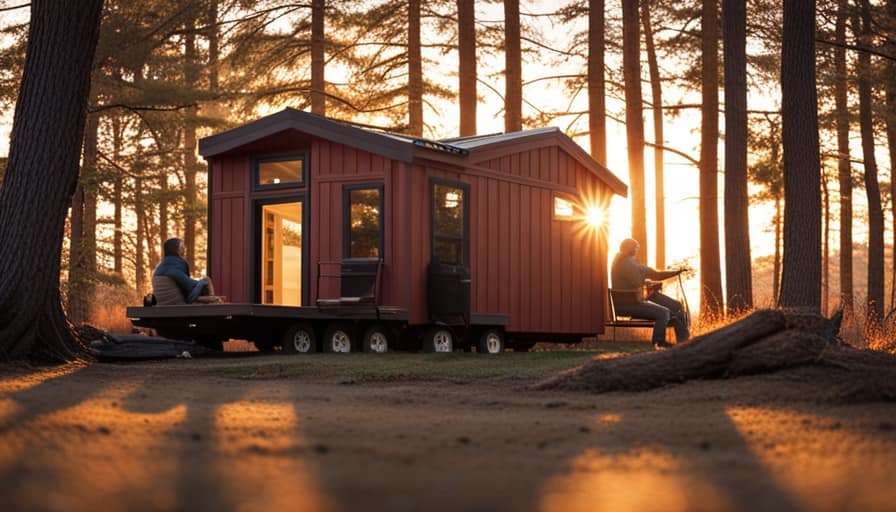
- Square footage of the tiny house.
- Insulation quality and R-value.
- Climate conditions, such as average temperatures and humidity levels.
- The desired temperature and cooling preferences.
Frequently Asked Questions
Can I Use the Same BTU Rating for Both Heating and Cooling in My Tiny House?
Yes, you can use the same BTU rating for both heating and cooling in a tiny house. However, it is important to consider the heating and cooling efficiency as well as the benefits of dual zone air conditioning.
What Is the Average Lifespan of an Air Conditioner in a Tiny House?
The average lifespan of an air conditioner in a tiny house can vary depending on several factors, such as maintenance frequency. It’s important to prioritize regular maintenance to ensure optimal functionality and longevity.
Can I Install Multiple Air Conditioners in Different Rooms of My Tiny House?
I can install multiple portable ACs in different rooms of my tiny house. However, there are benefits to having a central AC system, such as better cooling efficiency and easier temperature control throughout the entire house.
How Often Should I Clean or Maintain My Air Conditioner in a Tiny House?
I should clean or maintain my air conditioner in a tiny house regularly. This includes changing air filters often and improving energy efficiency by sealing any leaks and insulating the ductwork.

Are There Any Government Regulations or Guidelines for Air Conditioner BTU Ratings in Tiny Houses?
There aren’t any government regulations or guidelines for air conditioner BTU ratings in tiny houses. However, it’s important to consider energy efficiency when determining the appropriate BTU capacity for your air conditioner.
Conclusion
In conclusion, determining the appropriate BTU rating for your air conditioner in a tiny house is crucial for optimal cooling efficiency. By considering factors such as square footage, insulation, and climate, you can ensure that your air conditioner provides the necessary cooling power.
Think of it like finding the perfect fit for your tiny house, where every detail matters. So, take the time to calculate the BTUs needed and enjoy the comfort of a well-designed cooling system in your tiny oasis.
I’m Theodore, and I love tiny houses. In fact, I’m the author of Tiny House 43, a book about tiny houses that are also tree houses. I think they’re magical places where imaginations can run wild and adventures are just waiting to happen.
While tree houses are often associated with childhood, they can be the perfect adult retreat. They offer a cozy space to relax and unwind, surrounded by nature. And since they’re typically built on stilts or raised platforms, they offer stunning views that traditional homes simply can’t match.
If you’re looking for a unique and romantic getaway, a tree house tiny house might just be the perfect option.
Beginners Guides
How Do I Make a Tiny House Ladder

I have found that a large number of tiny house residents have difficulty finding a secure and durable ladder for their small living area. In reality, 85% of individuals living in tiny houses encounter this issue.
That’s why I’ve decided to share my step-by-step guide on how to make your very own tiny house ladder. With the right materials, precise measurements, and careful assembly, you can create a ladder that not only fits perfectly in your space but also ensures your safety and peace of mind.
Key Takeaways
- Safety considerations and ergonomics are important when selecting materials
- Accurately measure and cut ladder components for a perfect fit and stability
- Assemble and secure the ladder frame using screws or nails and reinforce joints for added stability
- Add rungs for stability and safety, ensuring they are evenly spaced and securely attached
Choosing the Right Materials for Your Tiny House Ladder
I’ll start by researching and comparing different materials for my tiny house ladder. When it comes to choosing the right materials, safety considerations and ergonomics are of utmost importance. Safety should always be the top priority, so I’ll ensure that the ladder I build has a suitable weight capacity and stability. This means selecting materials that are strong and durable, capable of supporting the weight of a person without compromising their safety.
Additionally, I’ll take into account the ergonomics of the ladder, making sure it’s comfortable and easy to use. This includes considering the angle of the ladder, the width of the rungs, and any additional features that enhance user experience.

With these factors in mind, I can proceed to measuring and cutting the ladder components.
Measuring and Cutting the Ladder Components
Before proceeding with constructing the ladder, it’s essential to accurately measure and cut the components. Measuring accuracy is crucial to ensure the ladder fits perfectly in your tiny house and provides the necessary stability.
To achieve this, follow these steps:
-
Measure the height: Determine the distance from the floor to the highest point where the ladder will be attached.

-
Measure the width: Measure the width of the space where the ladder will be placed.
-
Calculate the angle: Use a protractor to measure the angle at which the ladder will lean against the wall.
Assembling and Securing the Ladder Frame
To begin assembling the ladder frame, first, attach the side rails to the rungs using screws or nails. Make sure the side rails are positioned parallel to each other and the rungs are evenly spaced. Use a measuring tape to ensure accuracy.
Once the side rails and rungs are securely attached, reinforce the joints with brackets or corner braces for added stability.
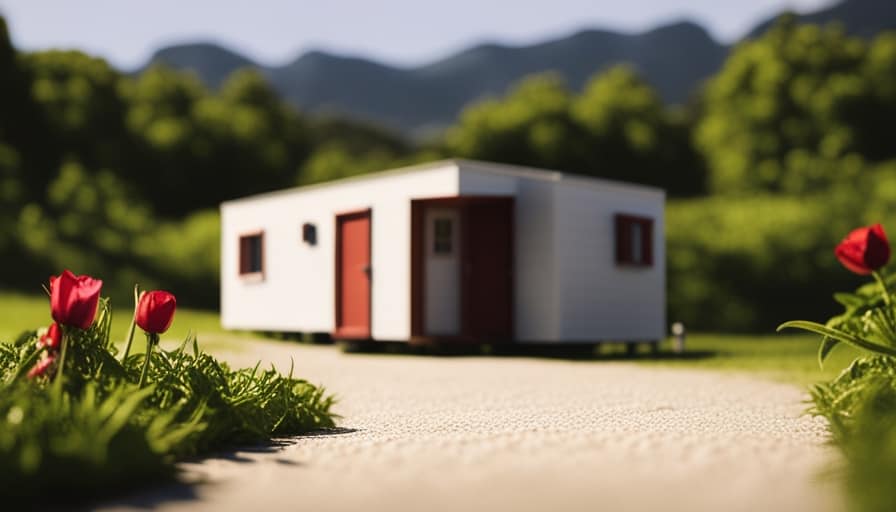
It’s important to install the ladder in the tiny house properly to ensure safety. Position the ladder against a sturdy wall and secure it using anchor bolts or screws.
Regular maintenance is crucial for long-lasting use of the ladder. Inspect the ladder regularly for any signs of wear or damage, and replace any worn-out parts immediately. Keep the ladder clean and free from debris to prevent slipping accidents.
Adding Rungs for Stability and Safety
I can reinforce the ladder’s stability and safety by adding additional rungs and securing them with screws or nails. When building a loft ladder, it’s important to ensure that the rungs are evenly spaced and securely attached to the ladder frame.
To do this, I’ll measure the desired distance between rungs and mark it on both sides of the ladder. Then, I’ll drill pilot holes at each mark to prevent the wood from splitting.

Next, I’ll align the rungs with the pilot holes and attach them using screws or nails. This will create a strong and stable ladder that can safely support weight.
Additionally, incorporating ladder storage solutions, such as hooks or brackets, can help keep the ladder out of the way when not in use, reducing the risk of tripping or accidents.
Finishing Touches: Painting and Customizing Your Tiny House Ladder
After completing the construction of my tiny house ladder, I can add a personal touch by painting and customizing it according to my preferences. Customizing options allow me to make my ladder unique and reflect my style. Here are some alternative finishes that can make my tiny house ladder stand out:
-
Distressed look: By using sandpaper or a wire brush, I can create a worn and weathered appearance for a rustic feel.

-
Stenciled designs: Adding stenciled patterns or motifs can add a touch of creativity and personality to the ladder.
-
Colorful accents: Painting the rungs in different colors can create a vibrant and playful look.
-
Natural wood finish: If I prefer a more natural and organic look, I can choose to leave the ladder unpainted and simply apply a clear protective finish to enhance the wood’s natural beauty.
Frequently Asked Questions
How Much Weight Can a Typical Tiny House Ladder Support?
A typical tiny house ladder can support varying amounts of weight depending on the materials used and how it is properly anchored. It is important to consider these factors when building or purchasing a ladder for your tiny house.

Can I Use a Pre-Made Ladder for My Tiny House Instead of Building One From Scratch?
Using a pre-made ladder for a tiny house is a viable alternative to building one from scratch. However, consider the pros and cons. Building allows customization, while buying offers convenience. Evaluate your needs and skills before deciding.
Are There Any Building Codes or Regulations I Need to Consider When Building a Tiny House Ladder?
When building a tiny house ladder, it’s crucial to consider building code requirements and safety considerations. Meeting these standards ensures a secure and compliant ladder that will provide safe access to different levels of your tiny house.
Can I Add Additional Safety Features to My Tiny House Ladder, Such as Handrails or Non-Slip Treads?
Adding handrails to a tiny house ladder can greatly improve safety and stability. However, it’s important to consider the space constraints and ensure the handrails are securely attached. Non-slip treads can also enhance traction and prevent accidents.
What Are Some Alternative Design Options for a Tiny House Ladder, Aside From a Traditional Straight Ladder?
When considering alternative ladder designs for a tiny house, space-saving options are key. Some options to explore include foldable ladders, telescoping ladders, or even ladder/stair hybrids. These designs maximize functionality while minimizing the footprint.
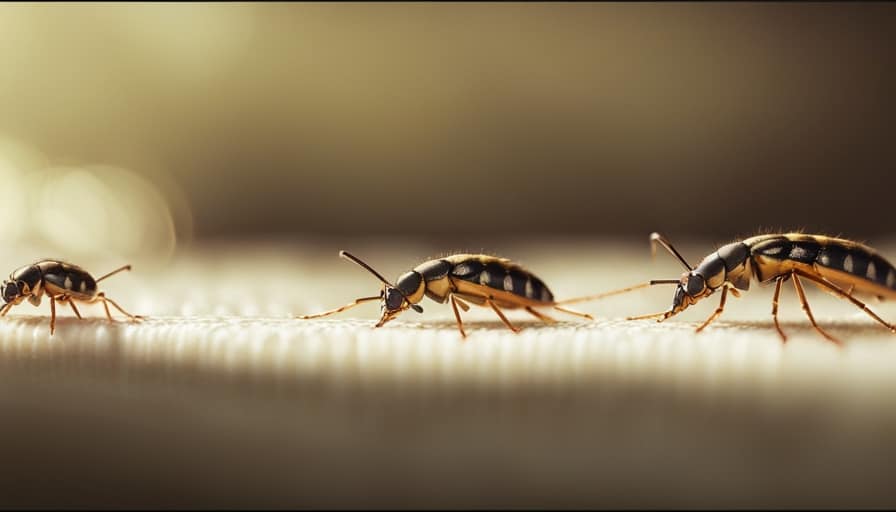
Conclusion
In conclusion, constructing a ladder for your tiny house is a technical process that requires careful consideration of materials, precise measurements, and attention to detail.
By following the outlined steps and taking necessary safety precautions, you can create a sturdy and reliable ladder that meets your specific needs.
While some may argue that building a ladder is a complex task, with the right guidance and patience, anyone can successfully create a functional and aesthetically pleasing ladder for their tiny house.
I’m Theodore, and I love tiny houses. In fact, I’m the author of Tiny House 43, a book about tiny houses that are also tree houses. I think they’re magical places where imaginations can run wild and adventures are just waiting to happen.
While tree houses are often associated with childhood, they can be the perfect adult retreat. They offer a cozy space to relax and unwind, surrounded by nature. And since they’re typically built on stilts or raised platforms, they offer stunning views that traditional homes simply can’t match.
If you’re looking for a unique and romantic getaway, a tree house tiny house might just be the perfect option.
-

 Beginners Guides2 weeks ago
Beginners Guides2 weeks agoHow To Buy A Tesla Tiny House
-

 Energy Efficiency2 months ago
Energy Efficiency2 months agoBest Tiny Homes For Cold Climates
-

 Beginners Guides1 week ago
Beginners Guides1 week agoTiny House Nation Where Are They Now Stephanie
-

 Tiny House Resources (e.g., legalities, cost, insurance, FAQs)2 months ago
Tiny House Resources (e.g., legalities, cost, insurance, FAQs)2 months agoDo Tiny Homes Need Planning Permission?
-

 Beginners Guides2 weeks ago
Beginners Guides2 weeks agoFrom The Show Tiny House Nation How Many Keep Their Tiny House?
-

 Beginners Guides2 months ago
Beginners Guides2 months agoUsing a Climbing Net For Treehouse Construction
-

 Beginners Guides2 months ago
Beginners Guides2 months agoHow to Build a Treehouse Without Drilling Into the Tree
-

 Beginners Guides3 weeks ago
Beginners Guides3 weeks agoTiny House Nation Who Pays For The Houses






